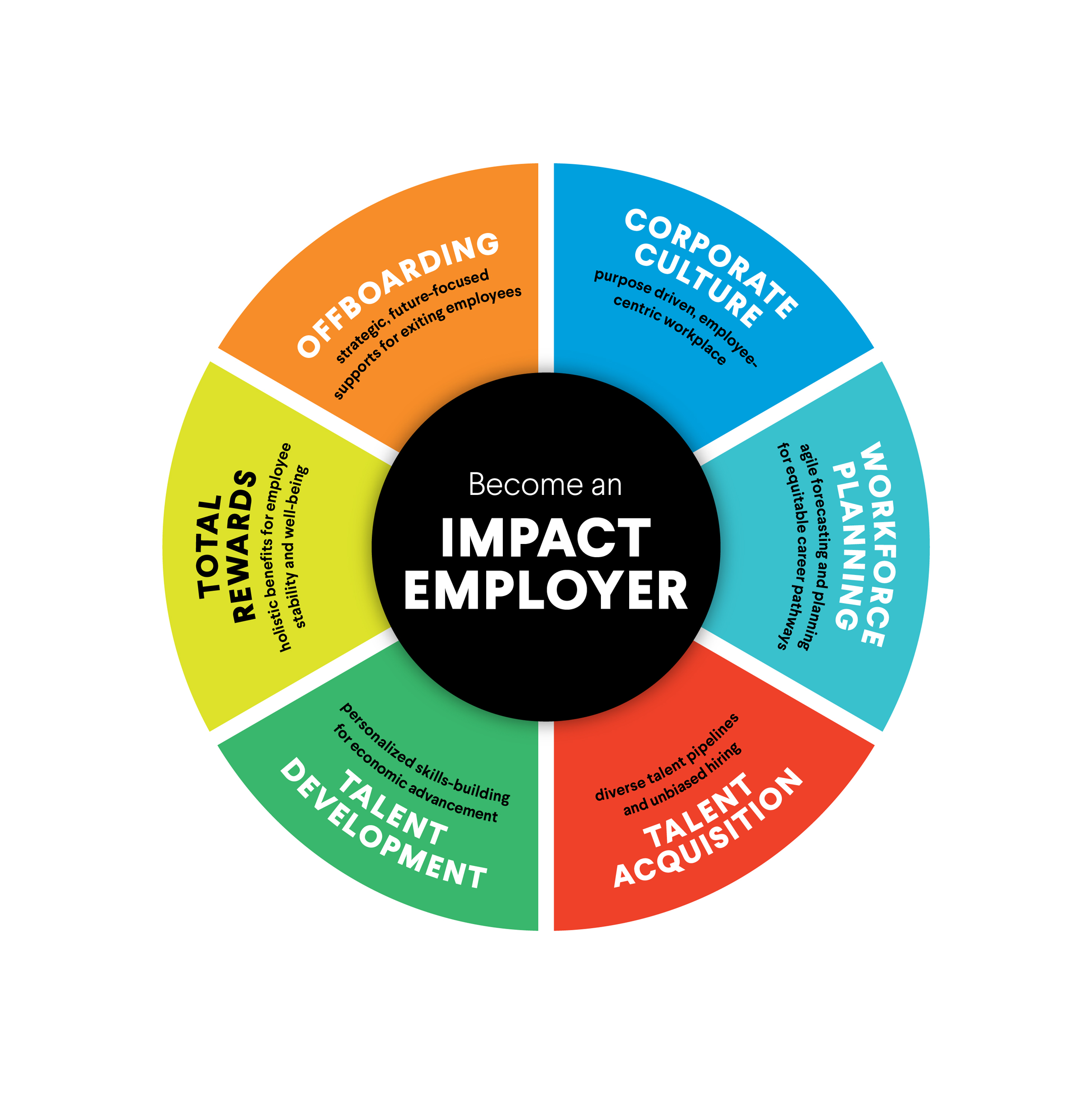
Employee Well-Being Is Critical to Equitable Economic Advancement
February 7, 2022
At a Glance
Our first Action Collaborative explored how corporate leaders can drive well-being initiatives to support their employees’ abilities to thrive at work. Here’s what we learned.
Is well-being at the top of your organization’s resolutions this year?
Corporate well-being includes more than traditional wellness initiatives like exercise and nutrition programs. JFF chose well-being as the topic for the inaugural Action Collaborative because we have seen how the events of the past few years have led to higher rates of anxiety, depression, and burnout, affecting employees’ ability to thrive at work. Bringing together corporate leaders and experts, this Action Collaborative focused on what it means to support employee well-being to foster greater stability and productivity and produce better long-term economic outcomes for everyone.
Why Employee Well-Being Is Essential
The concept of well-being is broad and includes mental, emotional, and financial well-being as well as an inclusive culture. As Action Collaborative Co-chair Sarah Keh, vice president, inclusive solutions at Prudential, noted, “Employee health and well-being are critical to a thriving company and contribute to increased employee engagement, productivity, and retention. Employees are looking to their employers to provide robust physical, mental, and financial health supports to help improve their well-being.” To set the conditions for well-being, the environment and culture must feel safe for employees. “You can’t truly have well-being if you don’t create a space of psychological safety where there is trust,” said one of our expert panelists, Farah Harris, CEO of WorkingWell Daily.
Successful well-being efforts are holistic and include a mix of formal programs and informal norms. Corporate leaders offered many examples of formal well-being initiatives like employee assistance programs (EAPs) and backup child care. However, formal efforts only go so far. Pairing them with informal norms is just as important. Action Collaborative Co-chair Susan McGotty, vice president, career services and talent marketplace at Prudential, noted the need “to create awareness around mental health issues to help remove stigma . . . so we can help to improve overall employee well-being, which is powerful.” These informal norms, like encouraging workers to step away from work during their lunch and meal breaks to improve mental health, can have a significant impact on employee well-being.
Suggestions for Centering Employee Well-Being
Using JFF’s Impact Employer Talent Framework as a guide for change, participants mapped their current well-being initiatives. Many of these are best practices for being an Impact Employer, but they are not always discussed in the context of supporting employee well-being as a necessary condition for economic advancement.


- Host education programs around mental health and well-being.
- Promote and provide resources to convene well-being committees.
- Invest in and promote use of employee assistance programs (EAPs).
- Minimize expectations of 24/7 availability to allow employees true time off.
- Focus on diversity, equity, and inclusion to create an environment for all employees to thrive.

- Staff projects so no one is overloaded.
- Ease anxiety by providing robust training for employees when implementing new technology.
- Create clear career pathways, particularly for frontline, entry-level, and mid-level workers who are most vulnerable.

- Let job candidates know during the hiring process about employee resource groups and affinity groups so they can find a point of connection.
- Notify candidates about the outcome of their job application or interview.
- Offer wraparound onboarding supports, such as guides, buddies, and schedules to help employees create relationships more quickly.

- Train leaders and managers to know where to direct employees to well-being resources.
- Encourage managers to talk with their direct reports about well-being during one-on-one check-ins.

- Expand EAPs to include mental health support.
- Bolster caregiving support for employees.
- Conduct a salary audit to ensure a living wage for employees.

- Adopt an ethical offboarding process.
- Show gratitude for employees throughout the layoff process.
- Offer severance buyouts, early retirements, and elective departures.
If you’re a corporate leader interested in helping your company invest in increasing employee well-being, here are three steps you can take now:
- Audit your current talent practices: What are you already doing on this list? What are you not doing? What could you start?
- Choose a starting place: Based on what you know your employees need most during this difficult time, what is one area on the Impact Employer wheel where you might start? Who could be your partners in that journey?
- Start small: Design a small-scale pilot to try one of these efforts, particularly if it’s brand new to your company. Capture what you learned and what it would look like to expand the pilot efforts to more employees.
Well-being involves both a top-down and bottom-up approach. A major challenge identified by Action Collaborative participants was how to share the many well-being initiatives their companies offer. One promising option to address this challenge came from a participant who suggested recruiting people to serve as ambassadors who can refer employees to the most helpful initiatives. Employees are often the best advocates for sharing their needs and resources in their workplace, and the idea of well-being is tailored to each individual. Dr. Katina Sawyer, cofounder of Workr Beeing, explained, “Everybody doesn’t define wellness the same way . . . and it is important to think about if we are producing workers who are less well than they were than when they started in our organizations because then we are depleting our workplaces of energy and decreasing performance.”
Well-being is a critical ingredient to making sure your employees can survive and thrive during this incredibly challenging time. It is essential to building a workplace that is equitable and inclusive, providing upward mobility for all employees.
JFF’s Action Collaboratives give corporate leaders the tools and expertise they need to put employee well-being, equity, and mobility at the forefront of their business strategies. Designed for peer-to-peer connections, these small groups offer a place to ideate, envision, and problem-solve—together.
Related Content

Recovery Playbook for Impact Employers
This special edition of our Impact Employer Framework offers insights into the unique challenges companies face in this moment, along with emerging practices to help business leaders navigate recovery from the COVID-19 pandemic and related…

Corporate Changemakers Series
The Changemakers series is produced as part of JFF’s Corporate Action Platform, which features stories of Impact Employers. This series tells the stories of people at the center of a growing movement that’s reshaping the…

Corporate Action Platform
Corporate Action Platform Corporate leaders tap into JFF’s influence, resources, peer groups, and tools to learn what works, engage with changemakers, and adopt best practices that drive real return for businesses and their workers. Learn…